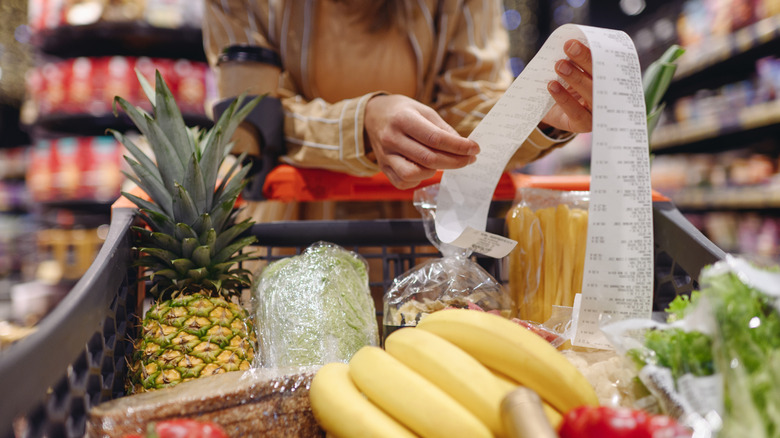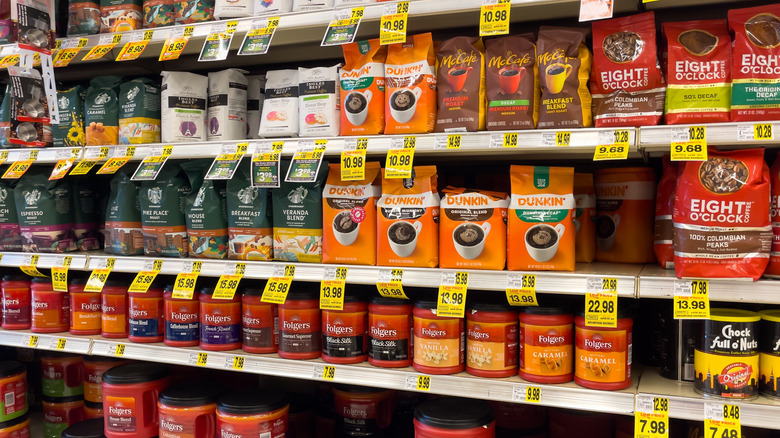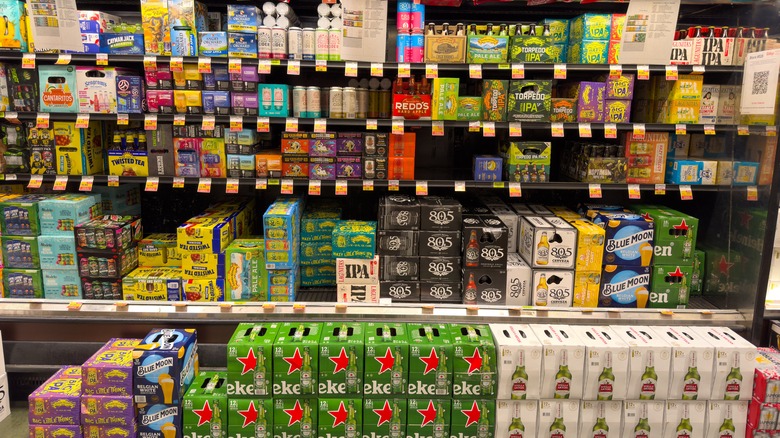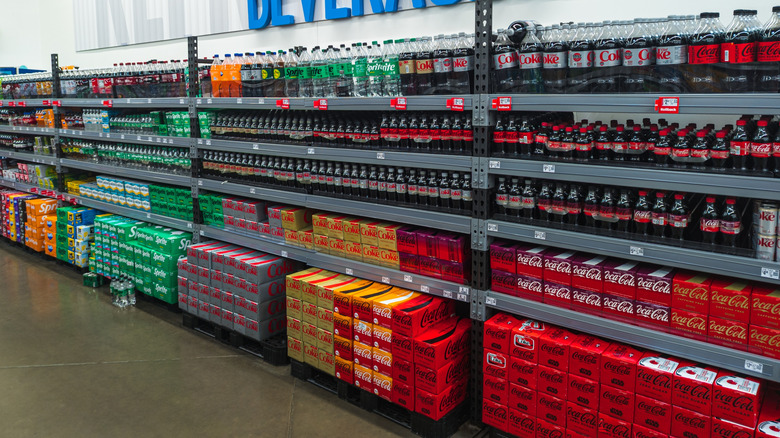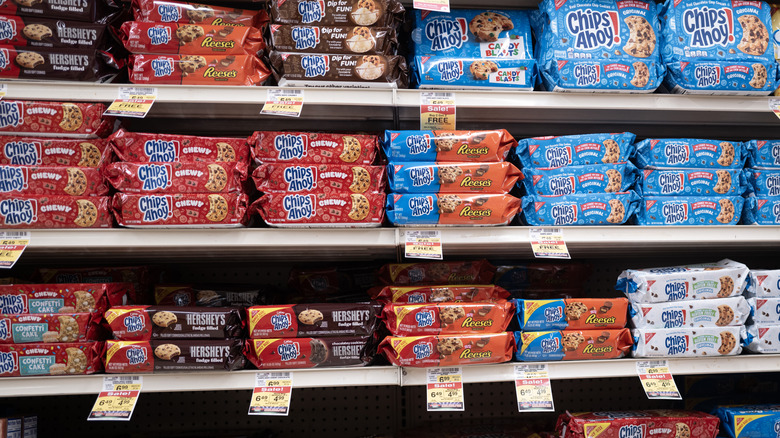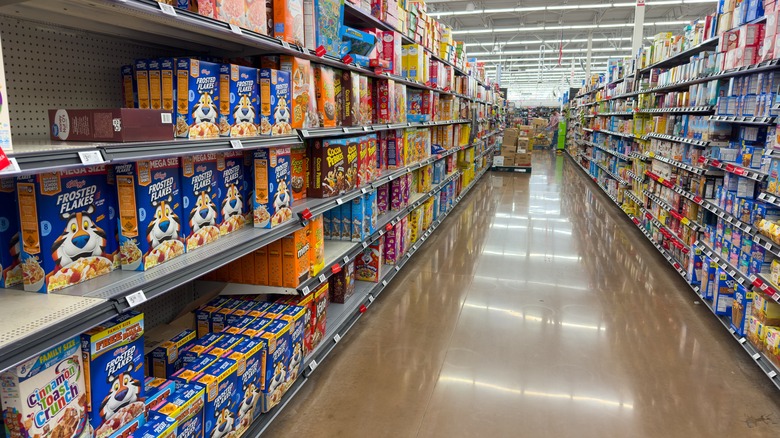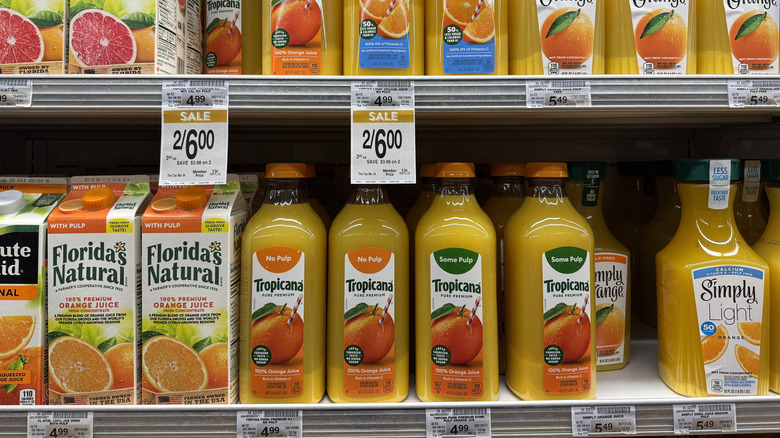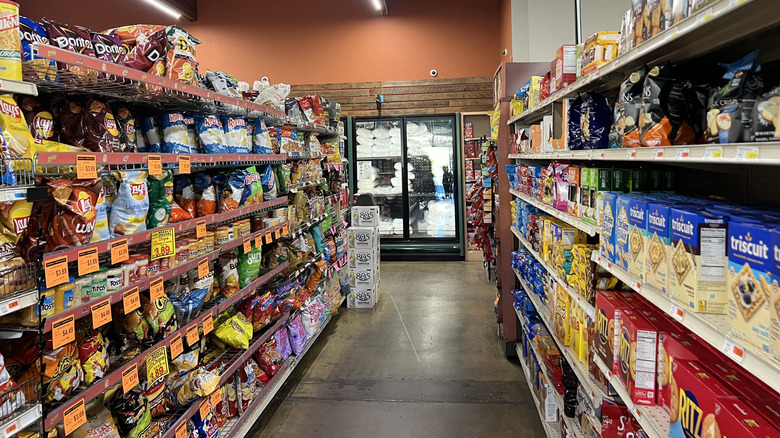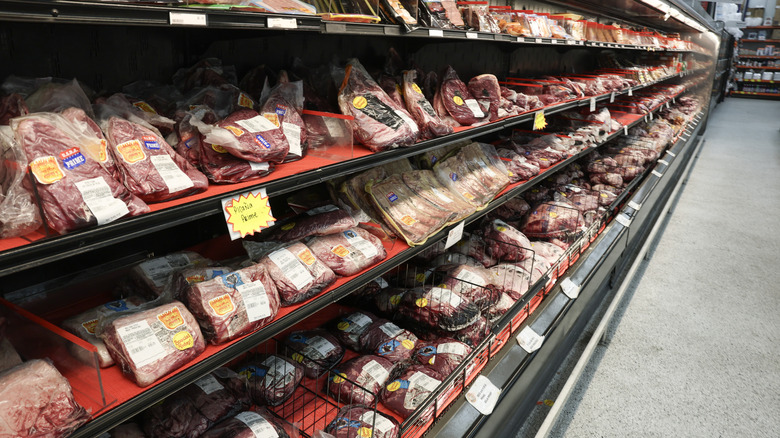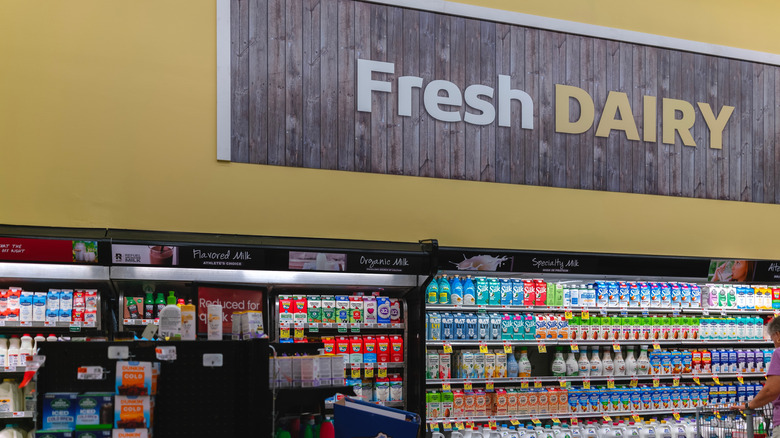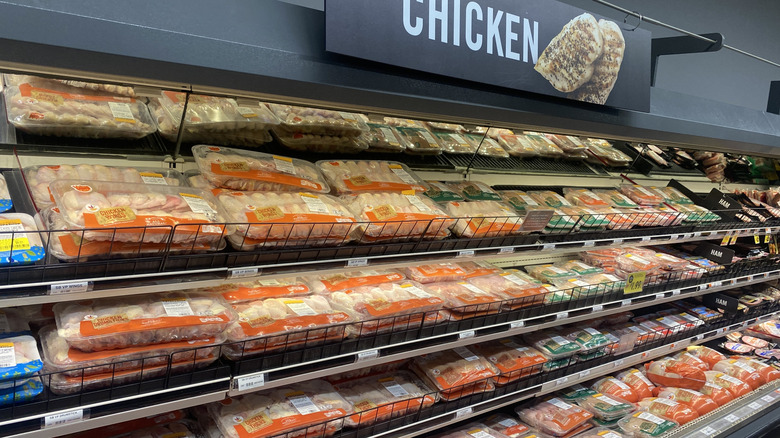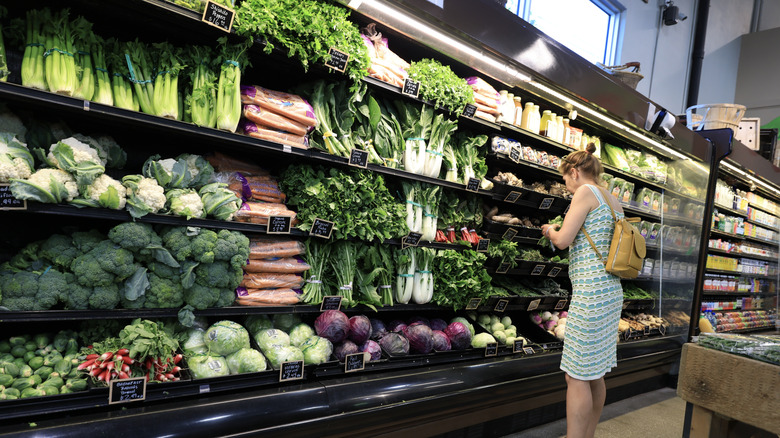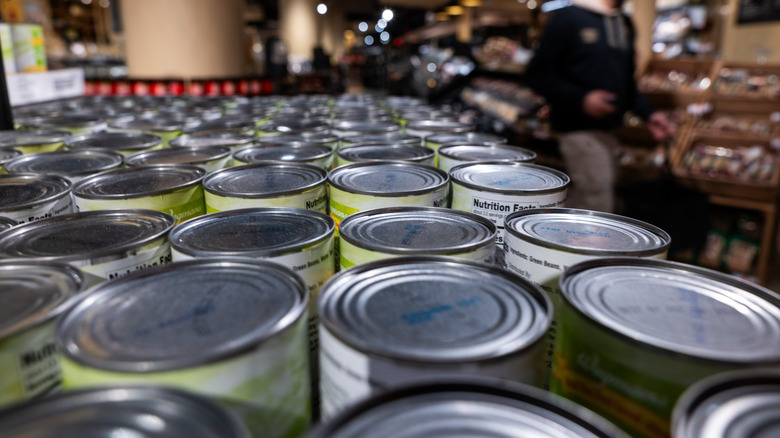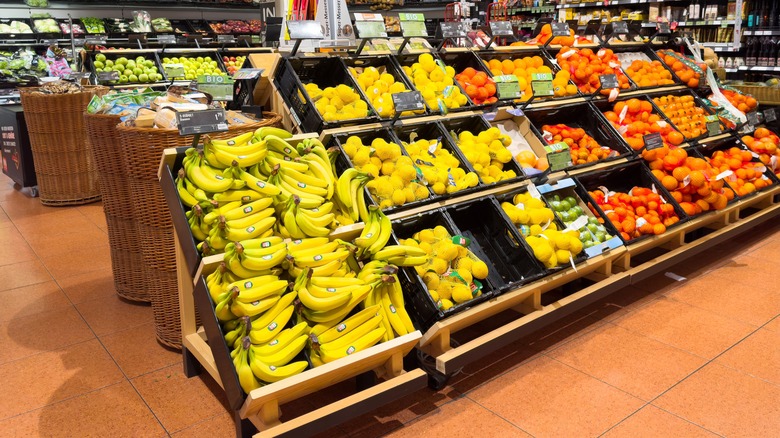15 Groceries Likely To Increase In Price This Fall
It's not your imagination; a trip to the grocery store is costing you more these days. It doesn't matter where you are — everything from produce to snacks to condiments have gone up in price this year. Even prices on some Costco items have doubled over the past few years. According to the Consumer Price Index, the overall cost for groceries has increased 2.7% over the past 12 months, with groceries in every category costing more today than they did this time last August.
In a recent survey from AP NORC, 86% of Americans say that they are feeling stressed over rising food costs and are making changes to what food and how much they buy at the store. And it appears that we're not yet done with the hits to our collective wallet. Farmers, manufacturers and economists all agree that prices on certain items are probably going to keep rising. A combination of factors is to blame, including U.S. tariffs on imported goods, bad weather and climate shifts, and labor shortages. We've taken a look at the trends in food costs and here are the 15 groceries we think are likely to increase in price this fall.
1. Chocolate
We're headed into a big time of the year for chocolate lovers. Halloween and Christmas mean chocolate candy, chocolate Christmas cookies, and festive holiday chocolate desserts. But if you've looked at the price of chocolate in the grocery store lately, you might be wincing at the thought of holiday baking. Severe weather in West Africa has caused a shortage in the supply of cocoa beans, and Fox43 reports that candy makers like Hershey have raised the prices of their candy bars by 26%. Stores are passing that cost increase to customers — in early September, convenience store Sheetz said they would have to increase the price of some Hershey candy sold in their stores.
It's not just candy bars; the price of cocoa powder and chocolate chips have gone up, too. The good news is that cocoa prices are starting to come down, but because companies buy so far in advance, consumer prices will likely continue to be high for the rest of this year.
2. Coffee
Coffee is a grocery staple that you are definitely paying more for lately. In the past five months, the price of coffee has grown 9.8%. 3.6% of that jump happened in just the past month. One reason is dry weather in coffee-growing places like Brazil, where Reuters reports that the crop production this year is expected to be between 3 and 6% lower than last year. And it's not just premium brands or your Starbucks' pumpkin spice latte. J.M. Smucker, who produces coffee brands Folgers and Café Bustelo, raised their prices twice this year and said that they will likely do so again later this year.
The other big reason is that only three places in the U.S. grow coffee: Hawaii, Puerto Rico and one location in California. That amounts to about 1% of the coffee consumed by Americans. Because we import almost all of our coffee, that means that the new tariffs on Brazil, Indonesia, and Vietnam are resulting in higher prices for coffee across the U.S.
3. Beer
The price of beer is growing primarily because of tariffs on both imported beer products and on the ingredients and packaging used for manufacturing in the U.S. Let's break down the imports on beer itself first. Back in April, the White House announced a 10% tariff on all imported beer. Beers made in the European Union and Japan have additional tariffs layered on top of that 10% (20% for the EU and 24% for Japan).
At the same time, the Trump Administration also announced a 25% tariff on all canned beer imports, as well as on empty aluminum cans. Aluminum cans are by far the preferred method for packaging beer for sale to individual consumers because cans provide better protection from light and air, plus they're lighter which means they're cheaper and easier to ship and store. About 60% of American-produced beer is packaged in cans and that means that even beer producers based here in the U.S. will see higher production costs.
4. Soft Drinks
The U.S. Department of Agriculture is predicting that the price of nonalcoholic beverages, which includes soft drinks, bottled water, and ready-to-drink tea and coffee, may increase by 3.6% by the end of this year. As with beer, it's primarily the tariffs on aluminum cans likely to drive these prices up. For example, Arizona Beverages sells their tall cans of iced tea for 99 cents, but in an August interview, they said that tariffs on aluminum might force them to increase that price.
But there's a special reason you might specifically see the price of Coca-cola increase later this year. In July, the company announced that they plan to launch an option for cane sugar-sweetened Coke in the U.S. this fall. Right now, high fructose corn syrup costs less than cane sugar, partly because the U.S. imports more sugar than corn. You can see the likely impact if you compare the cost of Mexican coke, made with cane sugar, to regular Coke — Mexican coke is almost double the price.
5. Cookies
There are several reasons you're seeing the price of cookies and other sweets rise at the grocery store. A package of chocolate chip cookies, for example, is 1.5% more expensive than this time last year. The rising cost of sugar and chocolate are likely partly to blame; when ingredients get more expensive, the final product is almost certainly going to cost more. The U.S. Department of Agriculture is predicting that prices for sweets are likely to increase by 4.7 percent by the end of this year.
But there's another reason your sweet treats are more expensive, and it's based on some sleight of hand from manufacturers. Shrinkflation is when a food manufacturer keeps the packaging size and cost of that package the same, but decreases the amount of items in the package. A survey out of Purdue University found that 53% of consumers have noticed shrinkflation happening in packaged sweets, so while your package of cookies may cost the same, you're actually getting less of the good stuff.
6. Cereal
Yes, your bowl of morning cereal has gotten more expensive lately and is probably going to continue to cost more. The price of cereal has increased 5.4% over the last 12 months, and it has increased faster than the inflation rate for groceries in general. Like other products, climate shifts and labor shortages are affecting the cost of this grocery staple. There's also the increased cost of ingredients like sugar and cocoa powder.
But there's a geopolitical reason as well — Ukraine is a major exporter of grains used to manufacture cereal. With the ongoing war with Russia, Ukraine isn't able to grow or ship as much grain out of the country. And even if your box of cereal shows the same price as it did last year on the shelf at the grocery store, it might actually be more expensive because there is less cereal in the box. Shrinkflation is an issue with packaged cereals as well.
7. Orange Juice
Oranges are having a tough time, both in the U.S. and around the world. In the 2024/2025 U.S. growing season, there was a 10% drop in orange production from the previous year. Extreme weather, climate shifts and a serious bacterial infection called citrus greening are the top causes of the orange drop-off. It's so bad that some orange farmers are calling it quits, including a major supplier to Tropicana.
The decrease in supply is causing consumers to pay more at the grocery store for orange juice. On average, a 64-ounce container of orange juice saw an 8.5% increase from last year. Frozen juice concentrate prices have also increased, almost doubling over the last five years. While U.S. juice makers might consider importing oranges, lower production is a global issue. Brazil is also dealing with citrus greening, as well as flooding and drought; the country's 2024 harvest was the worst in 36 years.
8. Chips
In August 2024, a 16-ounce bag of potato chips cost the average shopper $6.25. In August of this year, the average cost for that same bag is $6.75. That might not seem like a big increase, but the price of chips is growing faster than other grocery prices. Since February 2021, chips prices have increased 29% while grocery prices overall have only increased 23%.
Why the big price jump? Record warm weather years in Idaho and Washington, the two states that grow just over half of the potatoes in the U.S., have caused a decrease in production. The same problem with too-warm weather is happening in Pennsylvania. That matters because the largest number of chip factories are located in the state and they prefer to buy locally-grown potatoes instead of paying the high shipping costs. Given that grocery prices are expected to continue increasing and extreme weather keep happening, it's likely that chip prices are going to continue rising.
9. Beef
You might think that because a lot of beef is produced in the U.S. that it's safe from cost increase, but that's not the case. Extreme weather and supply issues are having a major impact on beef prices at the grocery store, something that's likely to continue through the fall. The U.S. Department of Agriculture is predicting that beef prices will increase 9.9% this year; in just month this summer, from June 2025 to July 2025, prices increased by 2.5%. One problem is that herd sizes have dropped; they're at the smallest they've been in 75 years. Drought and the growing cost of cattle feed are some of the factors contributing to smaller herds.
And there's an impact from tariffs here, too. U.S. beef producers import lean trimmings from countries such as Brazil that gets mixed with U.S. beef with a higher fat content for hamburger and other ground beef blends. Buying in bulk from warehouse chains may allow you to find cheaper steaks for now, but even those prices are likely to increase this fall.
10. Dairy Products
The price of milk is rising. A gallon of fresh whole milk costs 4.5% more today than it did a year ago. Just from June to July of this year, the cost for that gallon of milk rose 13 cents. Some chains have been able to keep store brand milk prices low, but it's possible that could change over the rest of the year. One reason milk costs more because dairy herds are smaller — fewer cows means less milk.
American-made cheese is getting a little more expensive, too. On average, a pound of cheddar cheese is selling for $6.04 in grocery stores, which is an increase of more than 4 cents from June of this year and more than 44 cents from this time last year. And if you like specialty cheeses from Italy and France, those are likely going to get more expensive this fall because of the 15% tariff on European Union countries.
11. Chicken
Beef isn't the only meat that's about to get more expensive. Chicken prices are going up as well. In August of last year, a pound of boneless chicken breast cost $3.95 on average. This August, that same pound costs $4.21. The cost of a whole chicken has gone up almost 10 cents over the last 12 months and overall, the USDA predicts that poultry prices overall will increase 2.5% this year.
The poultry industry is still recovering from avian flu outbreaks, but the increasing cost of corn and soybeans used in chicken feed and labor shortages (partially due to deportations) are having a major impact on chicken producers as well. There's also the cost of energy needed to grow, transport, and process chickens – the price of natural gas and diesel is also increasing, which means it's more expensive to get chickens from the farm to the grocery store. Chicken processing plants also have a difficult time finding employees in the U.S., with over half of new workers quitting within 90 days.
12. Fresh Produce
In July, the U.S. Bureau of Labor Statistics reported that the category of fresh and dry vegetables saw a massive price jump, with wholesale prices for domestic produce increasing by 38.9% compared to July last year. To be clear, this is the price grocery stores pay growers, not the increase in the price on the shelf. But at least one economist is sounding the alarm, predicting that prices in the grocery store could increase by as much as half by early next year.
Tariffs are certainly an issue for imported fruits and vegetables and are likely to contribute to higher prices for items like tomatoes that come from outside the U.S. But domestic price increases are happening primarily because of extreme weather and labor shortages. Many farms rely on the H-2A visa program, which brings in foreign workers to pick crops for lower pay than U.S. workers. With the U.S. tightening immigration policies, produce growers may have to pay more for labor or may risk not being able to harvest their crops, both leading to higher prices for consumers.
13. Canned Fruits and Vegetables
Typically, canned fruits and vegetables tend to be among the cheaper options at the grocery store, but that could change soon. The cost of canned goods, including canned fruits and vegetables and other canned products like soup and pasta are likely to rise this fall because of tariffs on steel and aluminum. While there are American-based can manufacturers, around 80% of the steel they use to produce cans for food packaging comes from outside the U.S. Most aluminum and steel being imported into the U.S. now faces a 50% tariff, meaning it costs more to make the cans.
Food Dive reports that the Consumer Brands Association estimates that the tariff on imported steel could increase the price of canned food by between 9 and 15%. These tariffs are likely to impact prices on other types of packaging and storage, too, as steel and aluminum is used in foil caps and other types of closures, as well as industrial steel drums used to store food.
14. Tea
Last year, the U.S. imported $550 million of tea. We are actually the second-largest importer of tea in the world, largely because we don't have the climate or terrain to grow tea in large quantities. Tea prices have increased around 15% over the last 12 months, and may continue to grow. Tariffs are playing a role, with a 50% tariff on goods from India which shipped 17 million kilograms of tea to the U.S. last year.
Another big reason for future cost increases is the end of "de minimis" shipping. In late August, the U.S. ended the exception that allowed merchandise worth less than $800 to enter the country duty-free. That means these small shipments will incur a cost that could be as much as up to $200 per package. Specialty tea shops that order from small tea farmers and producers are likely to feel this additional cost more and may have to pass it on to customers.
15. Bananas
Bananas are another food where the U.S. imports almost its entire supply, primarily from countries in Central and South America. Hawaii and Florida do grow a small amount of bananas, but not enough to provide the 24 pounds of bananas eaten by the average American each year. Almost half of the bananas we eat come from Guatemala and Ecuador. With the 10% tariff imposed on all imported goods, that means the price of bananas has gone up. Between April and August of this year, the price of bananas increased 4.9%.
Some potential good news, though: On September 5, the White House modified tariffs on some goods, including bananas, that cannot be produced in the U.S. for countries that already have a trade deal with the U.S. It's too early to tell if this will noticeably decrease food costs on items like bananas, but we'll keep an eye on what happens.
